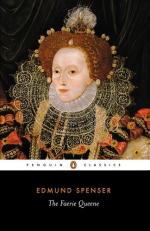134. FAIRE DRYOPE, a princess of Aechalia, who became a forest nymph. Pholoe, mentioned in l. 135, is probably a fictitious creation of the author’s.
146. DEAREST CYPARISSE, a youth of Cea, who accidentally killed his favorite stag and dying of grief was changed into a cypress. He was beloved by Apollo and Sylvanus.
148. NOT FAIRE TO THIS, i.e. compared to this.
152. N’OULD AFTER JOY, would not afterwards be cheerful.
153. SELFE-WILD ANNOY, self-willed distress.
154. FAIRE HAMADRYADES, the nymphs who dwelt in the forest trees and died with them.
156. LIGHT-FOOT NAIADES, the fresh water nymphs, companions of the fauns and satyrs.
161. THEIR WOODY KIND, the wood-born creatures of their own kind, e.g. nymphs or satyrs.
163. Una was “luckelesse” in having lost her knights, but “lucky” in the friendship of the Satyrs. Note the Euphuistic phrasing.
169. IDOLATRYES. The allegory has reference to the idolatrous practices of the ignorant primitive Christians, such as the worship of images of the Saints, the pageant of the wooden ass during Lent (see Matthew, xxi, and Brand’s Popular Antiquities, i, 124), and the Feast of the Ass (see Matthew, ii, 14).
172. A NOBLE WARLIKE KNIGHT, Sir Satyrane, in whom are united rude untaught chivalry and woodland savagery. He represents natural heroism and instinctive love of truth.
173. BY JUST OCCASION, just at the right moment.
184. THYAMIS is the symbol of Animal Passion; LABRYDE of the lower appetites; THERION, the human wild beast, who deserts his wife.
xxiv. This account of Sir Satyrane’s education is based on that of Rogero by his uncle Atlante in Ariosto’s Orlando Furioso, vii, 5, 7.
213. MAISTER OF HIS GUISE, his instructor.
214. AT HIS HORRID VEW, his shaggy, uncouth appearance.
256. HIS FAMOUS WORTH WAS BLOWN, i.e. blazoned by Fame’s trumpet.
308. A JACOBS STAFFE. According to Nares, “A pilgrim’s staff; either from the frequent pilgrimages to St. James of Comfortella (in Galicia), or because the apostle St. James is usually represented with one.”
371. See Canto III, xxxviii, where Archimago was disguised as St. George.
372. TH’ ENCHAUNTER VAINE, etc., the foolish enchanter (Archimago) would not have rued his (St. George’s) crime (i.e. slaying Sansfoy).
373. BUT THEM HIS ERROUR SHALT, etc., thou shalt by thy death pay the penalty of his crime and thus prove that he was really guilty. A very obscure passage. Look up the original meaning of shall.
386. This simile is found frequently in the old romances. Cf. Malory’s Morte d’Arthur, ii, 104, and Chaucer’s Knight’s Tale, l. 1160.
416. According to a usage of chivalry, the lover wore a glove, sleeve, kerchief, or other token of his lady-love on his helmet. By “lover’s token” Sansloy ironically means a blow.




